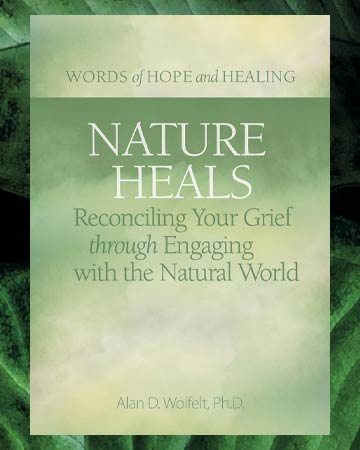Nature Heals
Author: Rachel Hunsell

Nature Heals is a validation of what I believe and what all of us innately know to be true about life and about grief. I belong in nature’s healing spaces. For it is in the outdoors I find myself woven into the fabric of the universe. I am my whole self when I am in nature. And because I am wholly present in nature my grief can exist too; it can be expressed, it can teach and it can evolve along with me.
Written by Dr. Alan Wolfelt, a member of the TAPS Advisory Board and Director of the Center for Loss and Life Transition, this easy-to-read book is packed with practical tools to navigate grief “the natural way.”
Invitation to Mourn
Nature is not an almighty cure to our grief, but rather an invitation to mourn and move through our grief in ways natural to the human experience.
Grief is a “natural internal experience [including our thoughts and emotions] that follows the separation of anyone or anything we are attached to,” and our need for mourning is an “outward expression of our internal grief.” From this understanding, Dr. Wolfelt opens us up to the healing possibilities of intentional mourning through time spent with the natural world.
Reconnecting with the Natural World
“Are you nature-deprived?” Dr. Wolfelt asks. For most of us the answer is yes at one time or another. This disconnection with nature plus grief has many of us feeling anxious, depressed and struggling to concentrate. Growing research shows we are innately connected to nature and our brains return to a more relaxed and focused state when we spend more time outdoors. We ruminate less and learn to practice mindfulness simply by being in nature.
Nature’s gift of awe can have profound effects. It allows us to feel connected to something bigger than ourselves and opens the door to explore our values and beliefs. We are yearning for hope and nature answers in healing.
Dr. Wolfelt Shares These Five Connections with Nature:
- Nature softens normal symptoms of grief. When we incorporate nature as a healer, we transition from anxiety, depression, and stress to increased endorphins, self-esteem, resilience, and more. We recognize we must “befriend all emotions as part of our grief,” but nature can help us carry the load when they become too heavy.
- Nature makes it easier to engage with the pain of grief in doses. Nature offers “grief hospitality; as space that does not force change, but offers change to take place within its safe space.”
- Nature teaches us about the natural cycles of life and death. From the changing of the seasons to the cyclical nature of plant lives and animal migrations, we come to understand that “change, destruction and rebirth are fundamental to life on earth.”
- Nature is truly our companion. Companioning is bearing witness, walking alongside, and holding safe space. This is nature, “steady and calming.”
- Nature is a place we can be our natural selves. The outdoors are a neutral, non-judgmental backdrop against which we can be who we are, just like the trees, clouds, rivers and critters. We accept nature as it is, inviting us to do the same for ourselves and one another.
Doses of Nature Into Your Daily Life
We know now nature can be a healer for us. But where do we begin? In the second half of this book Dr. Wolfelt explores just that.
“As with all things in grief, there is no right or wrong way — there is only what works for you.” Whether you’re an avid explorer or prefer indoor comforts, integrating your grief journey with nature simply requires intentionality, regular dosage, and removing barriers of expectations.
Getting Out Into Nature:
Think simple and nearby to start.
- Begin in your immediate surroundings by stepping out your front door. Begin to notice what’s around you: rocks, shrubs, trees...can you see the sky? You’re there. You’re in nature.
- Or get out into your neighborhood and community. Parks, gardens, and even cemeteries are often beautiful, quiet outdoor spaces perfect for contemplation.
- Choose activities engaging to you. Have a picnic, read a book, bird watch, join a club, play a game, volunteer, garden, exercise, watch a sunrise, learn about local flora and fauna. But don’t feel you need to take on extra effort or commitments if you’re not ready. Simply sitting in nature can be life changing.
Bringing Nature In:
Allow for curiosity and be open to changing your scenery.
- There have been countless studies on the positive impacts of looking at landscapes. Whether from a window, outdoor vantage point, or even on a screen helps us feel better, think better, and heal faster.
- We can incorporate nature into our homes through plants or fresh cut flowers. We can replace plastic baskets with ones made of seagrass, glass tables with ones of wood, empty end tables with collections of rocks and seashells. We can cover our walls with paintings and images or watch shows of our favorite landscapes and places.
- Our furry companions and choices of music also comfort our pain and bring smiles to our faces. From the food we eat to the smells of the candles and incense we burn, nature is always around us. It holds memories and opens the doors to healing.
“Grief is a wilderness,” Dr. Wolfelt says. But when we bring the wilds of our grief into the wilderness of our natural world we come to know we are not alone. We are all connected: humans, plants, rivers and mountains. Nature —like fellowship in our survivorhood— feeds the spirit and renews us. Nature heals.
Book by Alan D. Wolfelt, Ph.D.; Reviewed by Rachel Hunsell, Program Manager of TAPS Outdoor Engagement
